
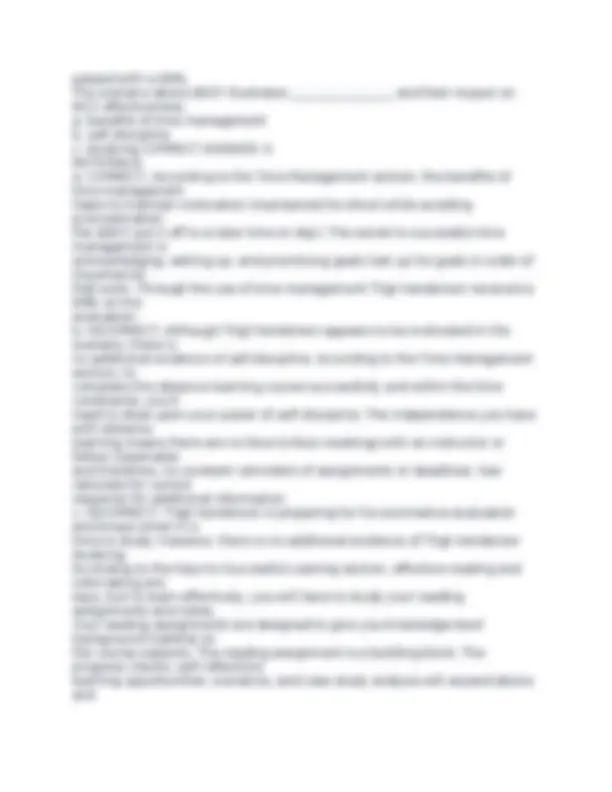
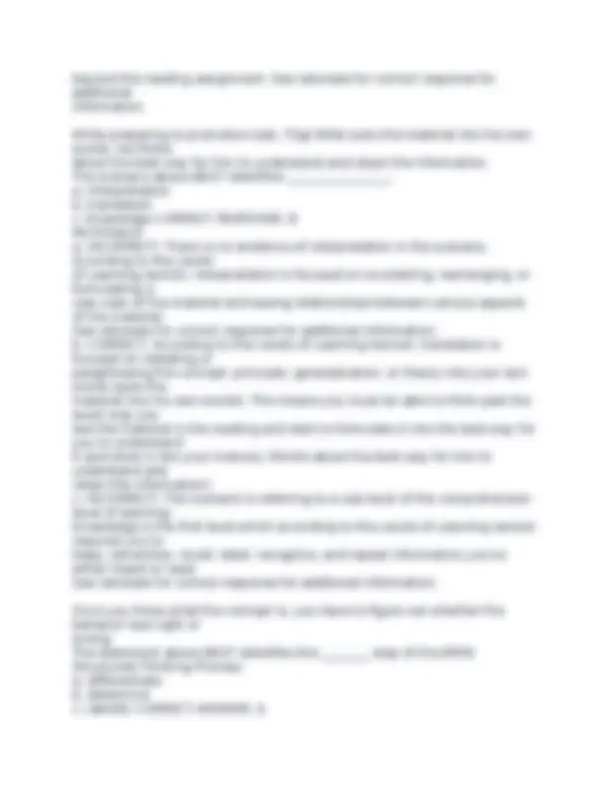
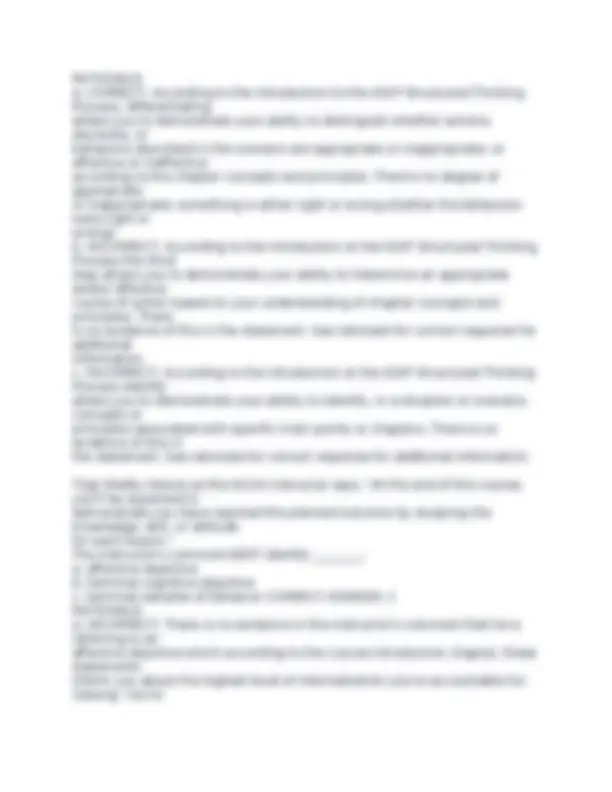
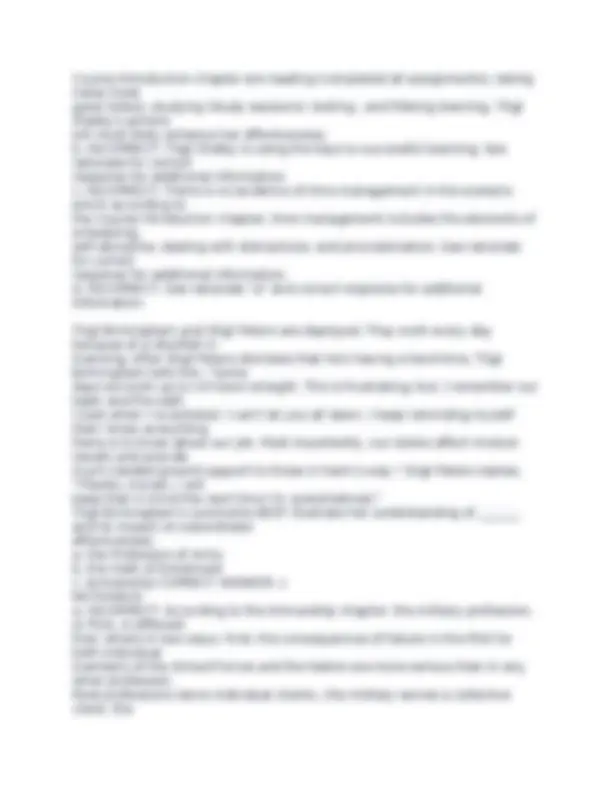
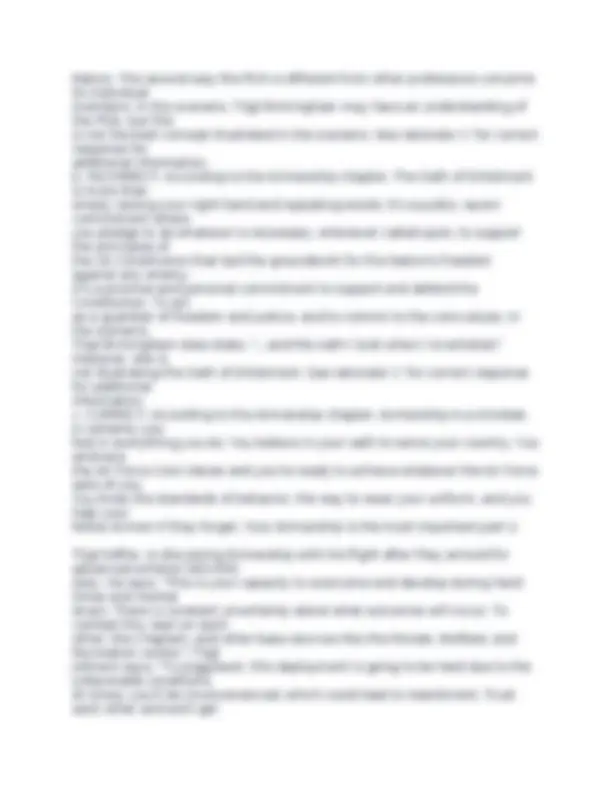
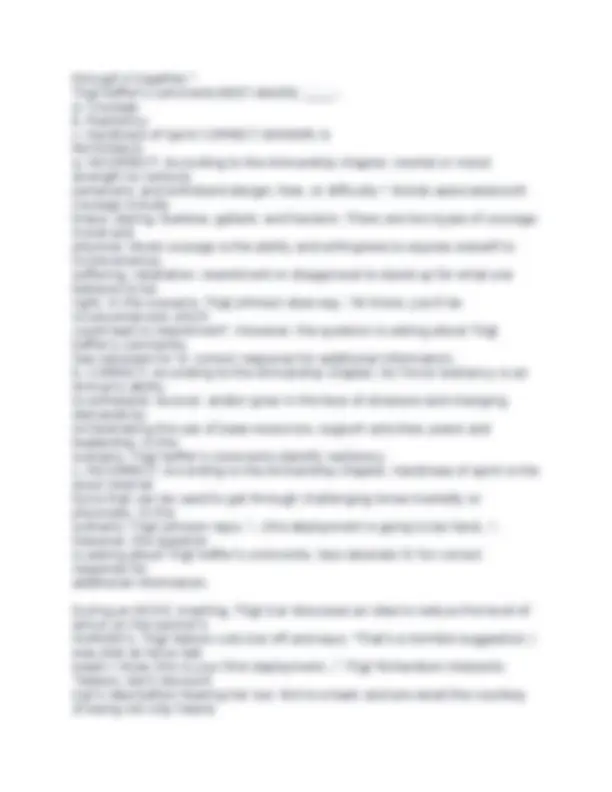
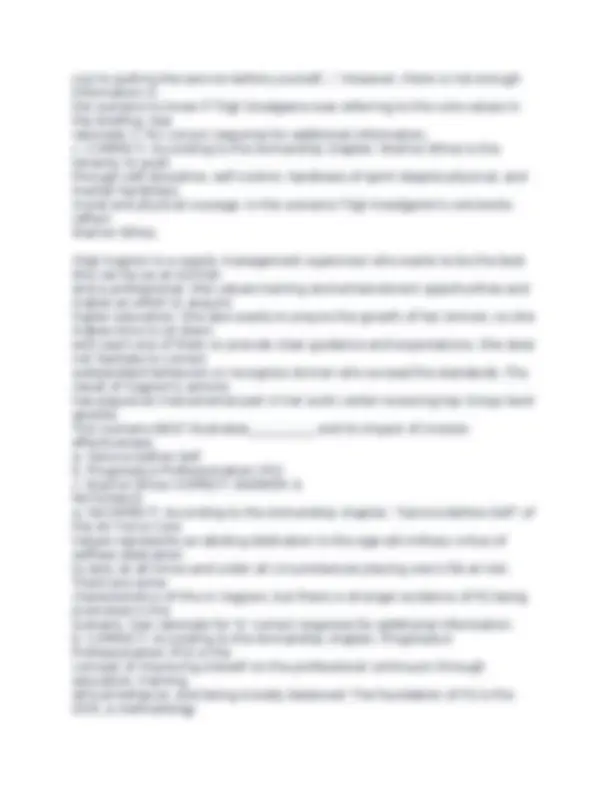
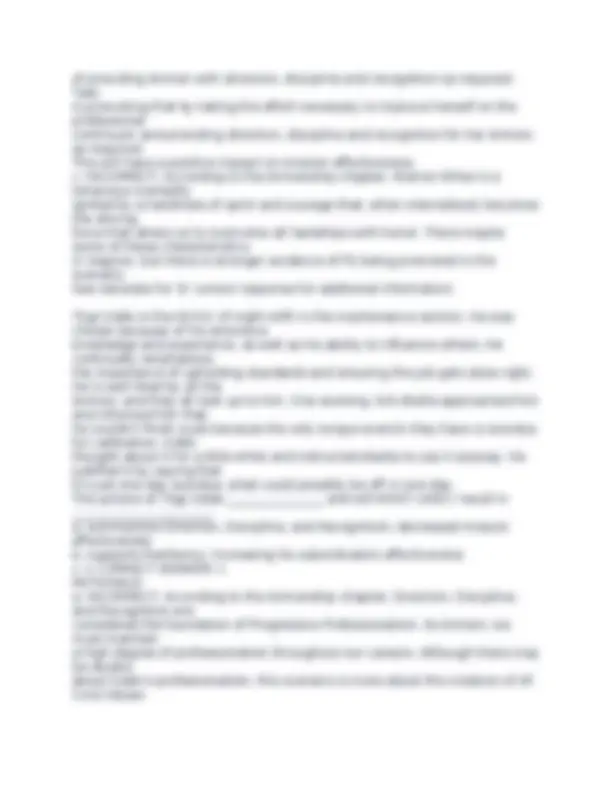
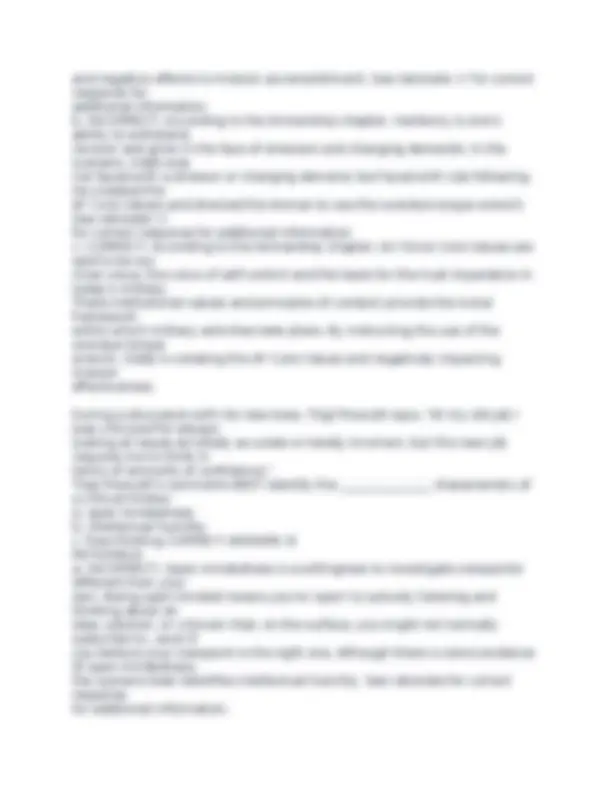
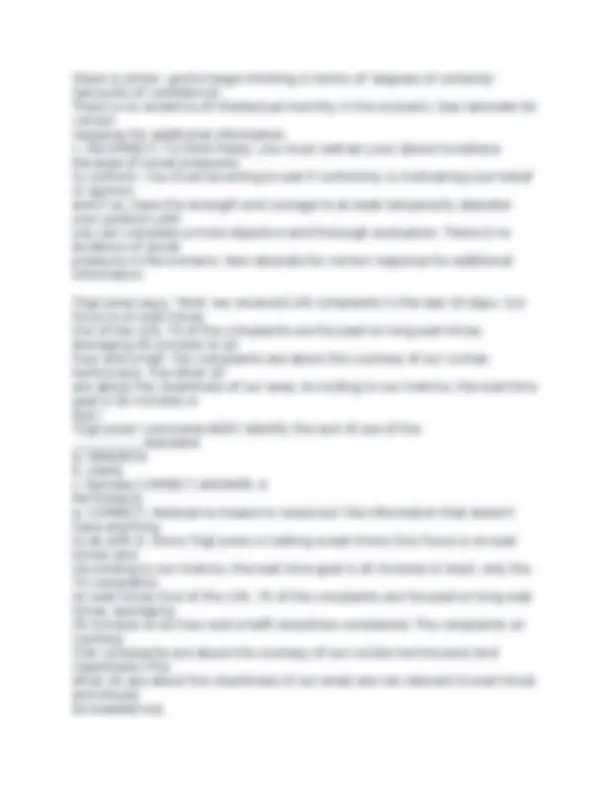
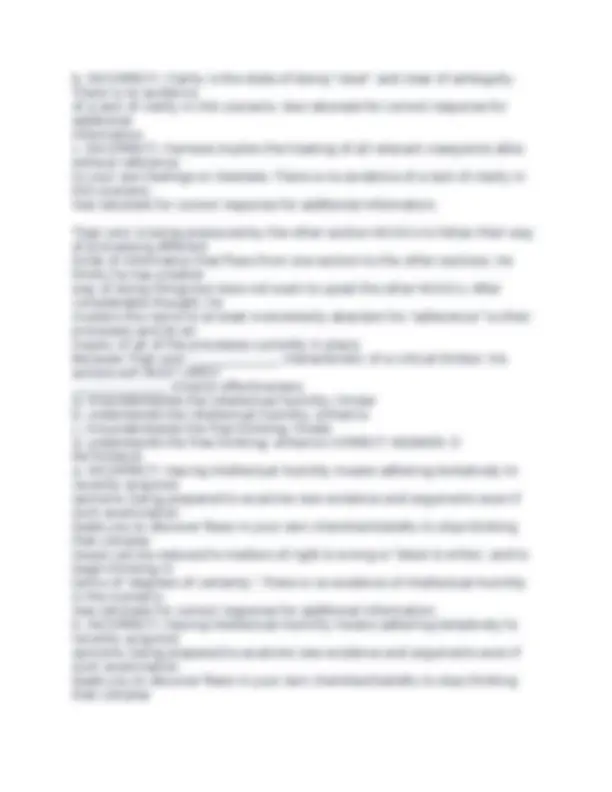
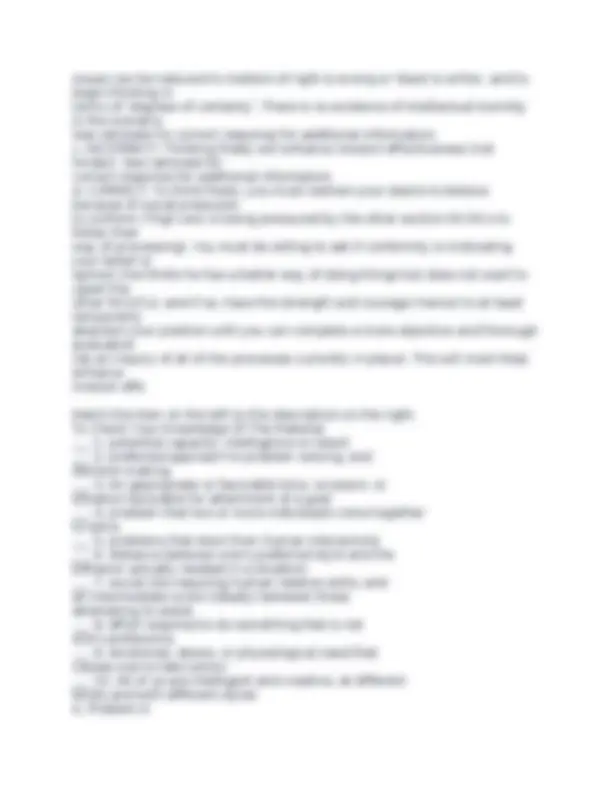
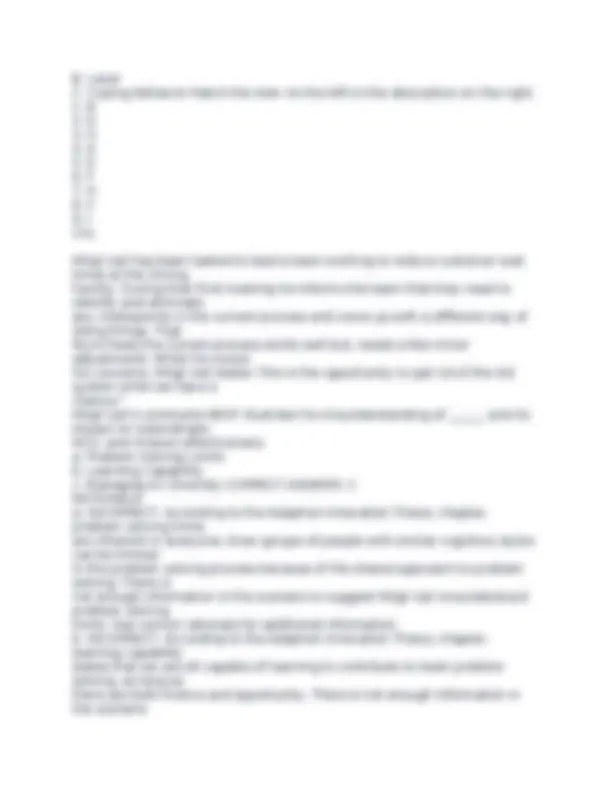
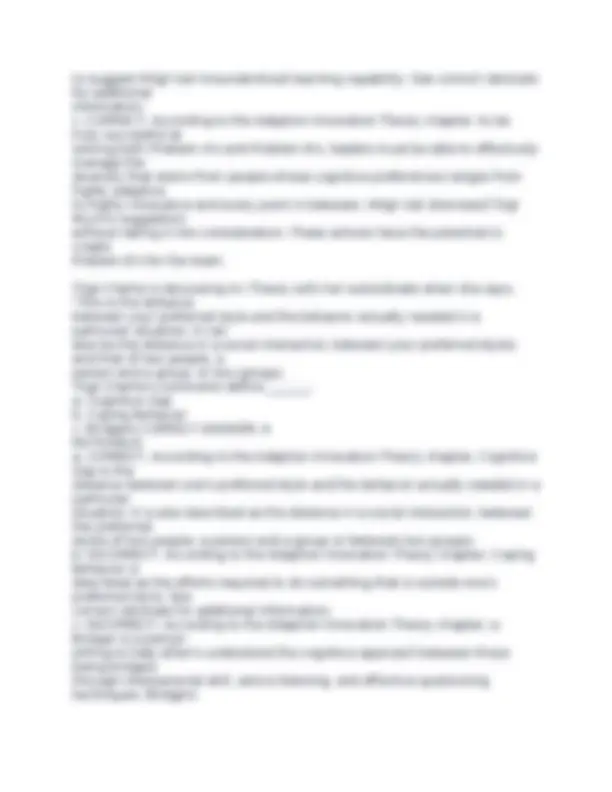
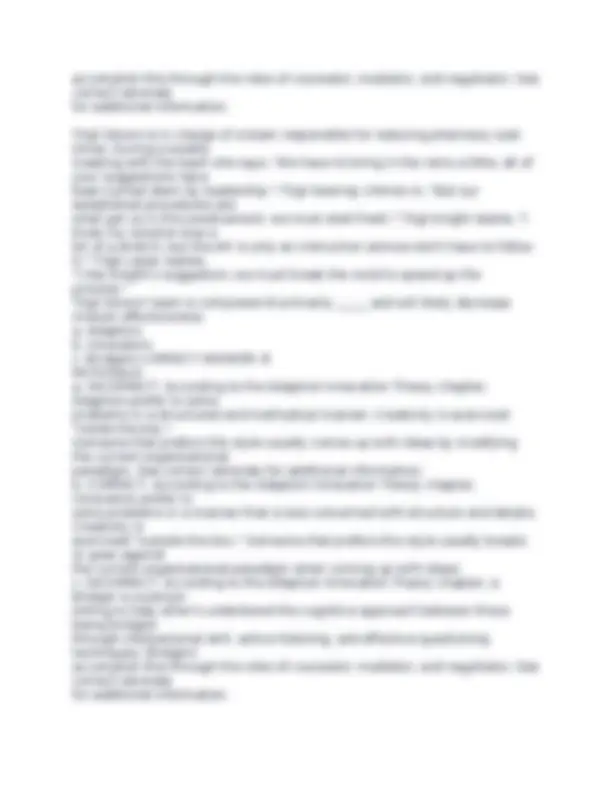
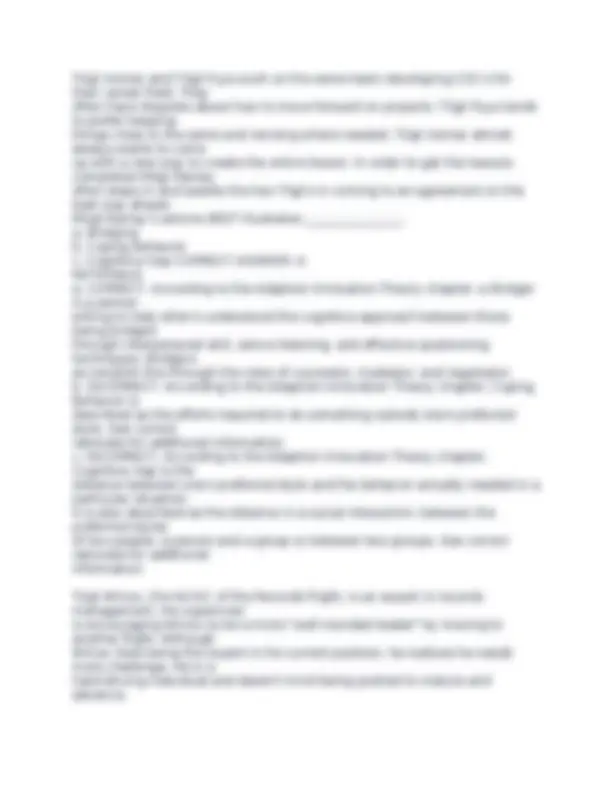
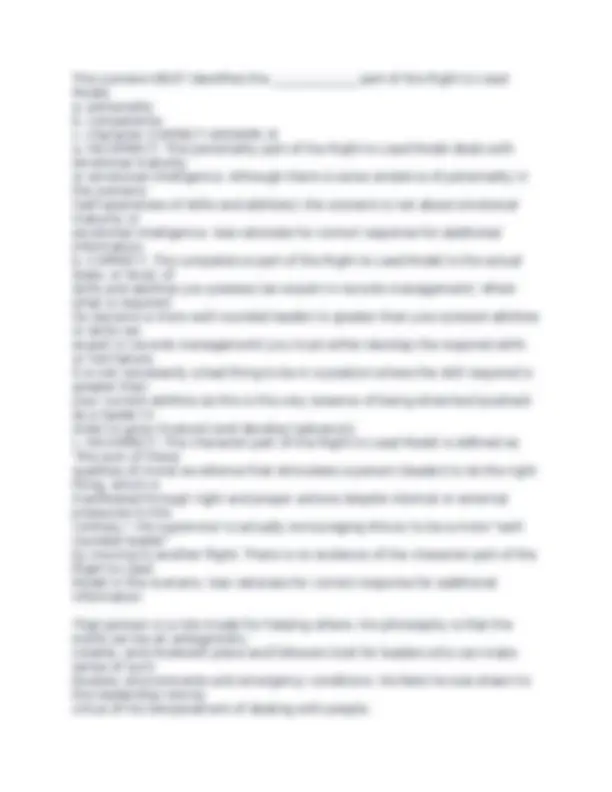
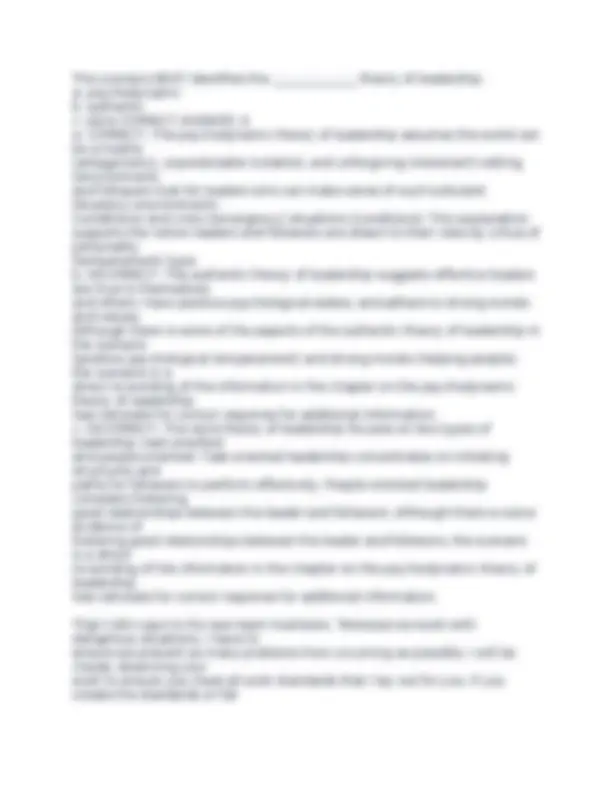
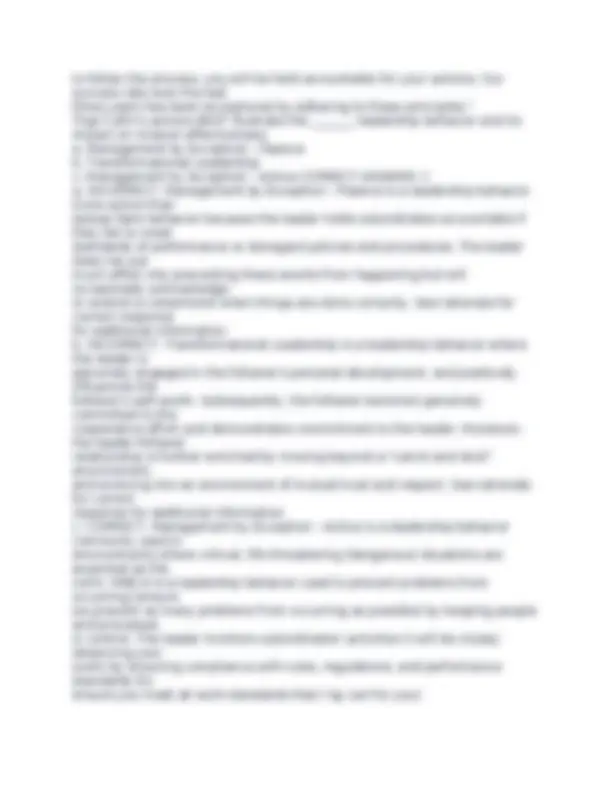
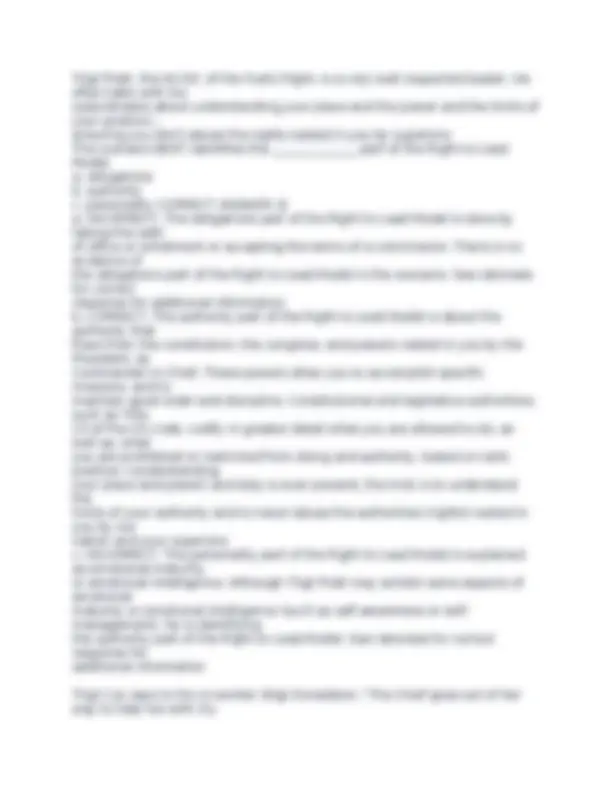
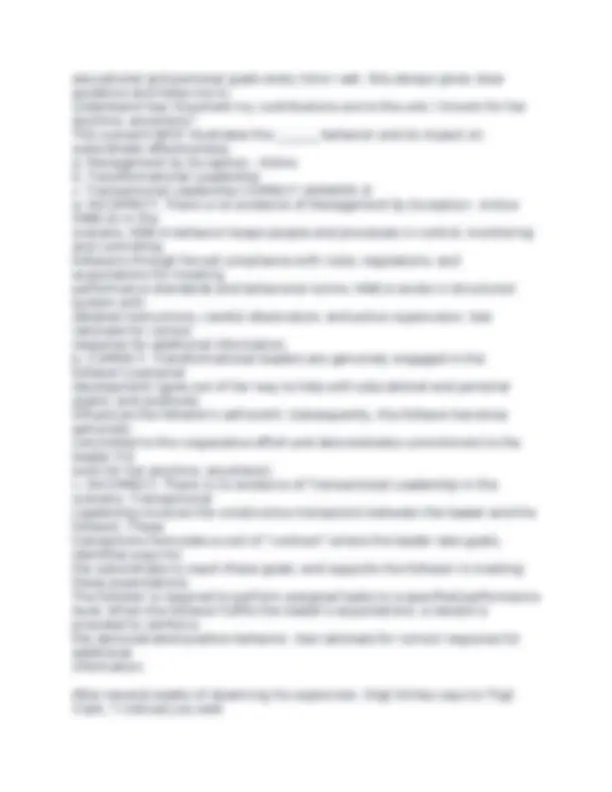
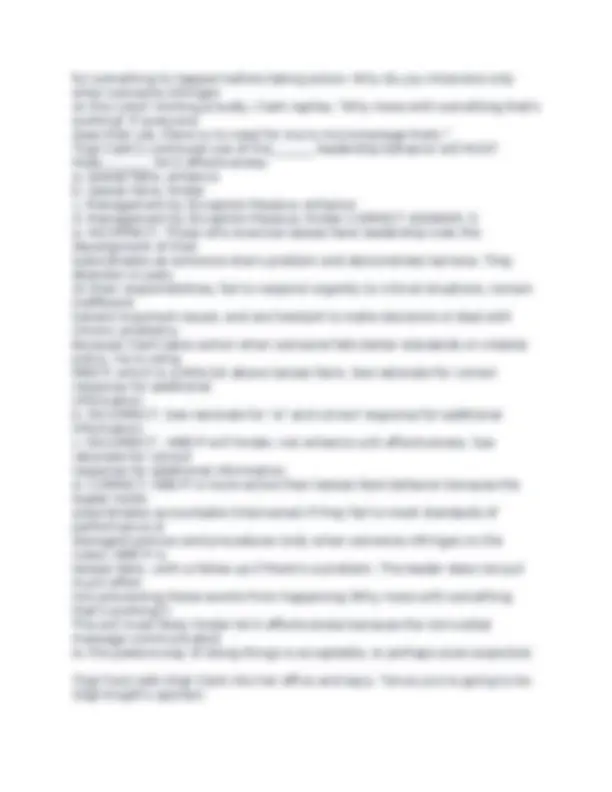
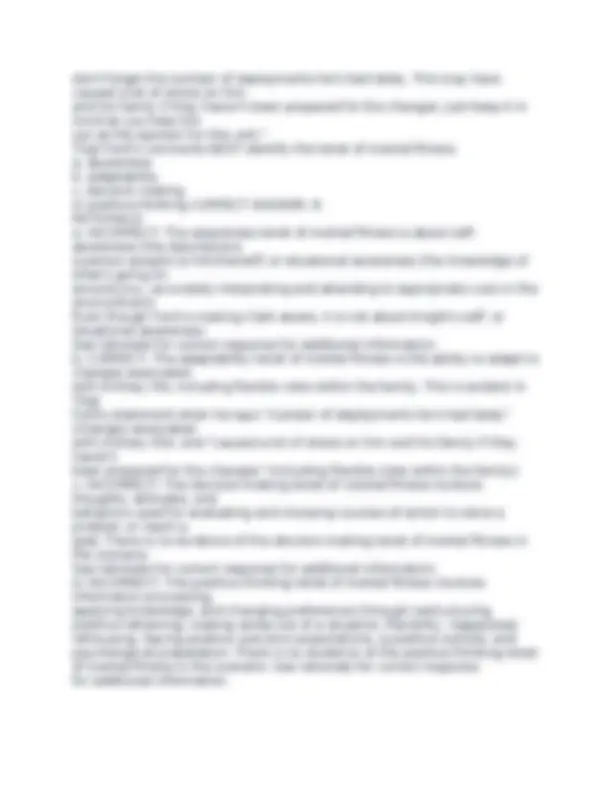
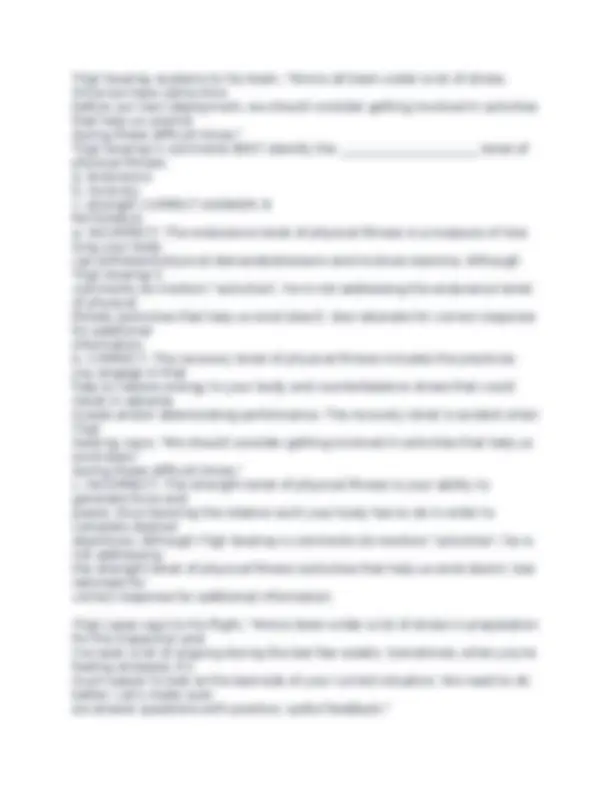
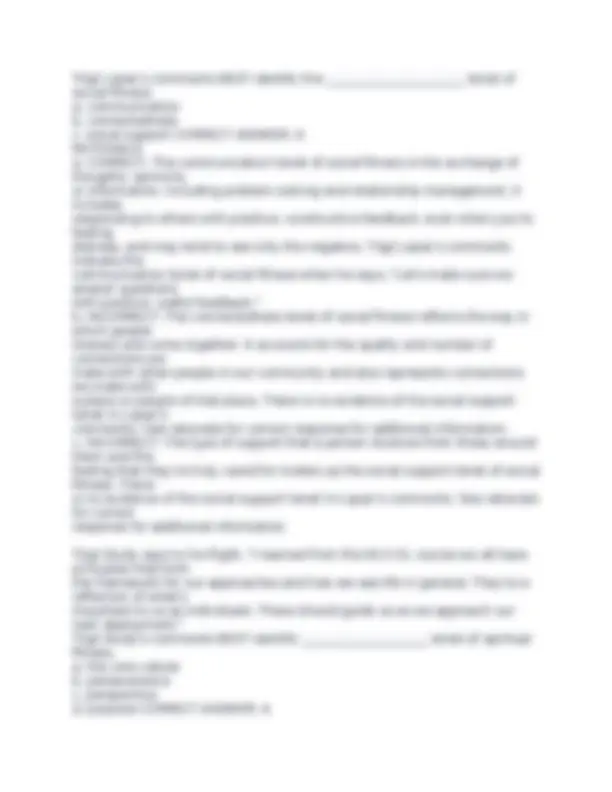
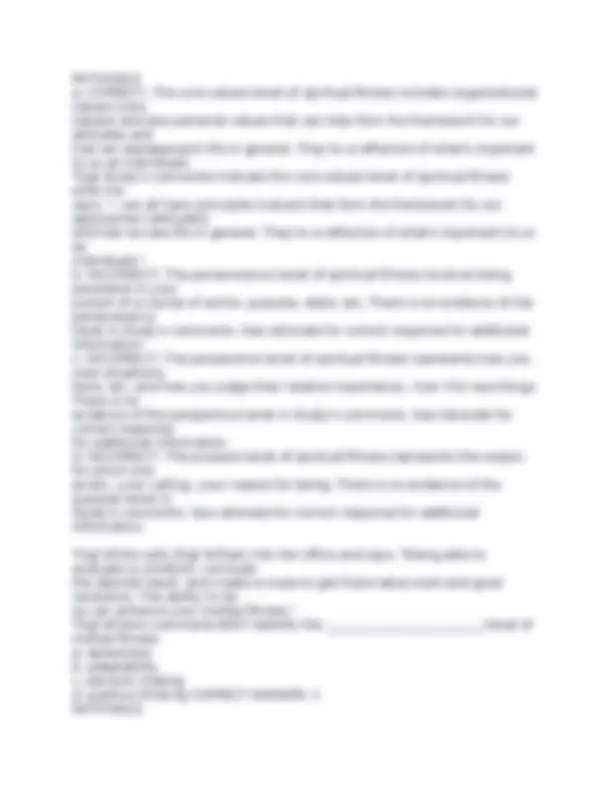
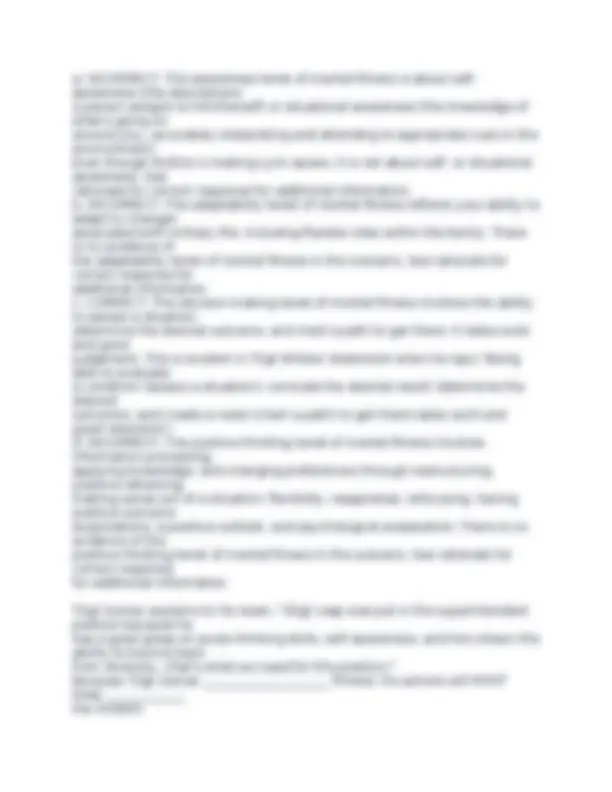
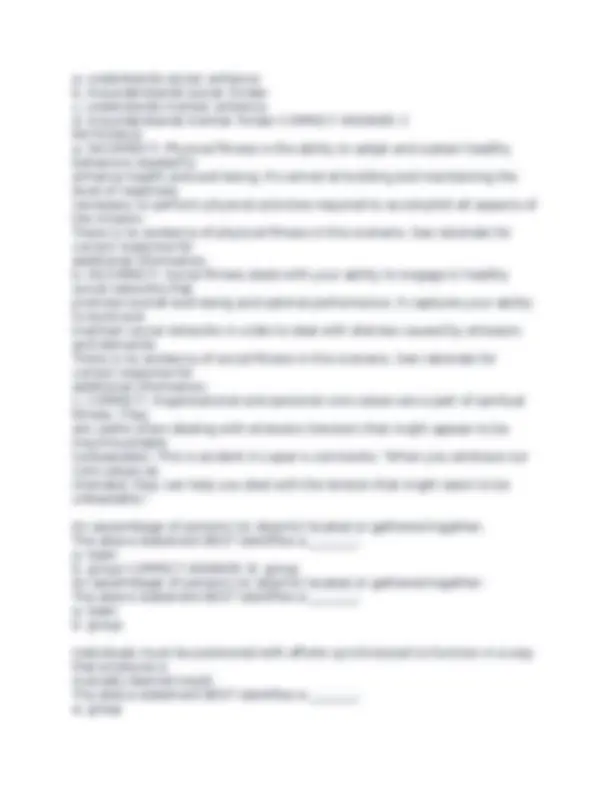
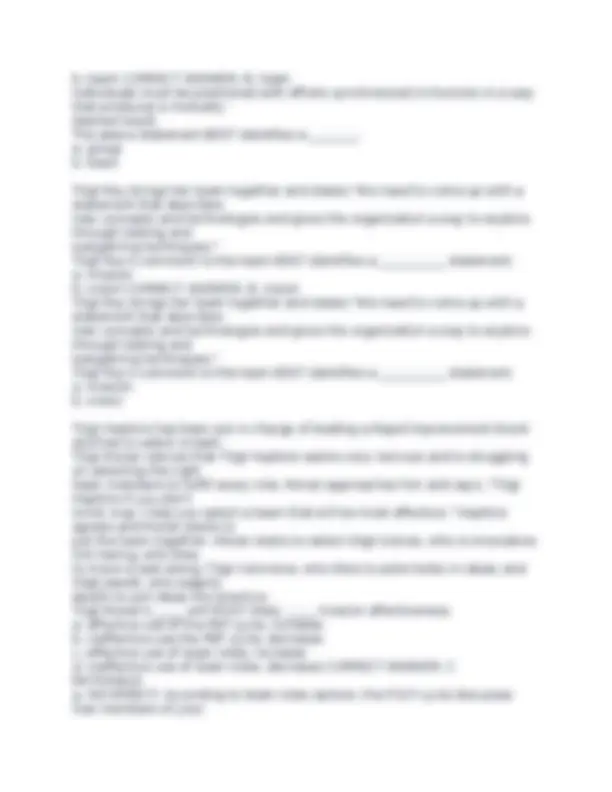
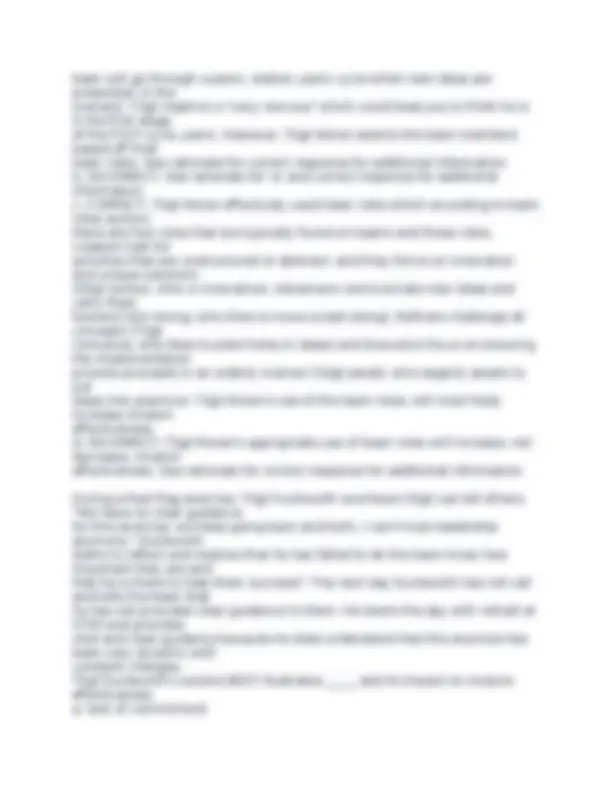
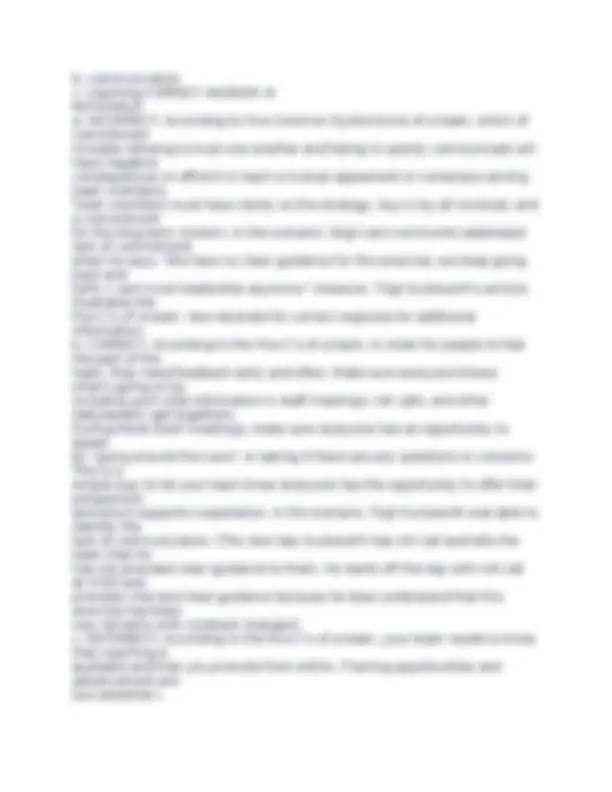
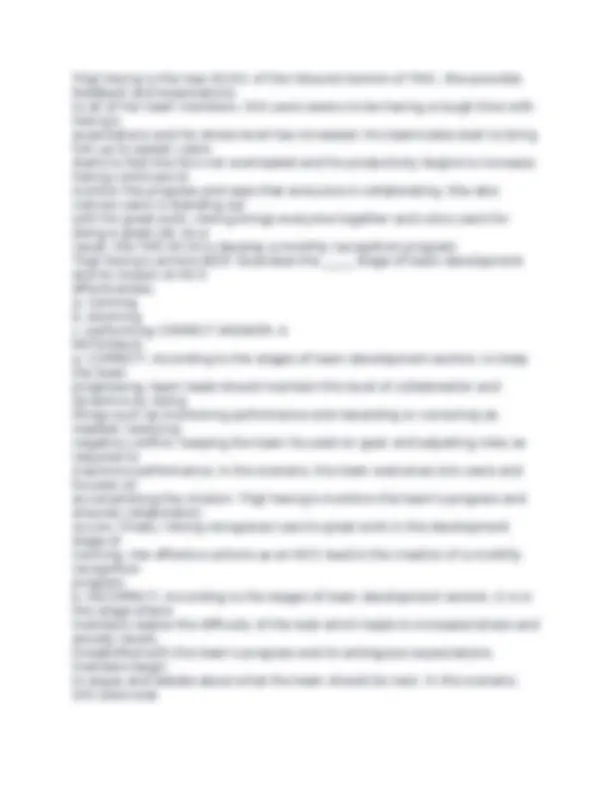
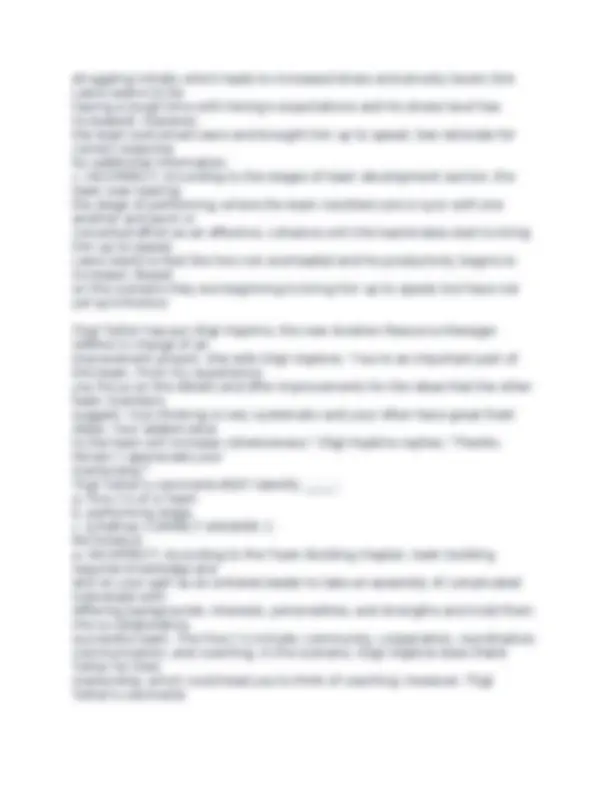
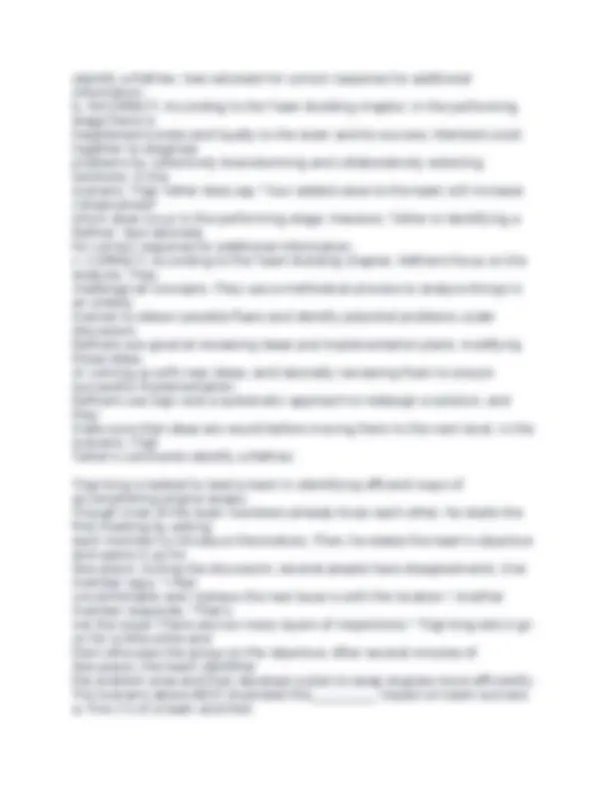
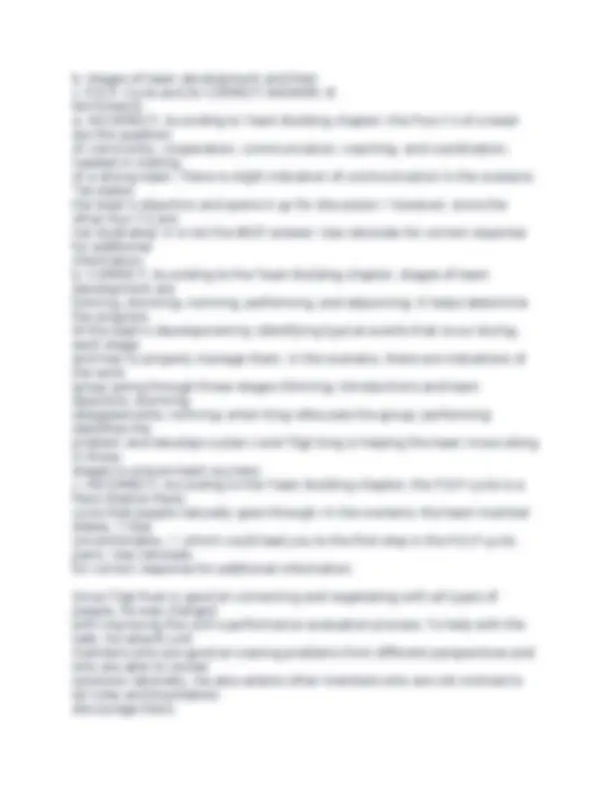
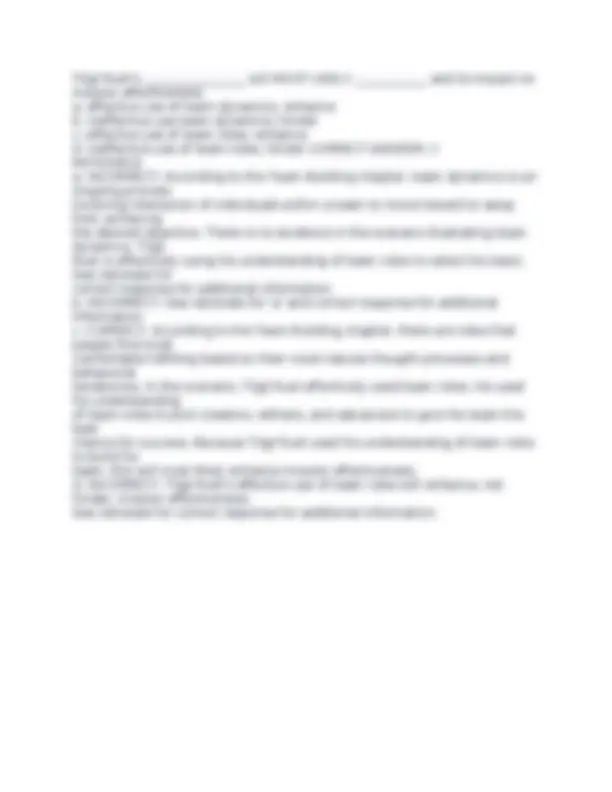


Study with the several resources on Docsity

Earn points by helping other students or get them with a premium plan


Prepare for your exams
Study with the several resources on Docsity

Earn points to download
Earn points by helping other students or get them with a premium plan
Community
Ask the community for help and clear up your study doubts
Discover the best universities in your country according to Docsity users
Free resources
Download our free guides on studying techniques, anxiety management strategies, and thesis advice from Docsity tutors
The importance of time management and the keys to successful learning, as demonstrated through the actions of various airmen. It highlights the benefits of time management, such as maintaining motivation and avoiding procrastination, as well as the keys to successful learning, including reading, taking notes, studying, testing, and lifelong learning. The document also covers topics related to respect, intellectual humility, mental fitness, social fitness, team dynamics, and team roles. Overall, the document provides insights into how airmen can effectively manage their time and apply the principles of successful learning to enhance their personal and professional development.
Typology: Exams
1 / 44

This page cannot be seen from the preview
Don't miss anything!





































The statement above BEST identifies ________. a. Air Force Core Values b. The Enlisted Force Structure c. Institutional Competencies Development and Management CORRECT ANSWER: C RATIONALE: a. INCORRECT: According to the Air Force Requirements section, the core values are ethical and moral obligations of Air Force employees, provides the foundation for professional character, and guides Airmen's personal and professional conduct. There is no evidence of the core values in the statement. See rationale for correct response for additional information. b. INCORRECT: According to the Air Force Requirements section, the purpose of the Enlisted Force Structure is to ensure that all enlisted Airmen understand what the Air Force expects from them at each rank. There is no evidence of the Enlisted Force Structure in the statement. See rationale for correct response for additional information. c. CORRECT: According to the Air Force Requirements section, one document, AFMAN 36-2647, Institutional Competencies Development and Management, contains a great deal of expectations in relation to the Institutional Competencies and serves as a foundational document for all EPME curricula. TSgt Browning just passed her final NCO DLC summative evaluation. She decides to review her test results and thinks about how she is going to use this to improve herself. She also thinks about how she can use the information she learned in her work center. TSgt Browning's actions BEST illustrates ___________________. a. lifelong learning
b. testing c. taking notes CORRECT ANSWER: A RATIONALE: a. CORRECT: According to the Keys to Successful Learning section, Lifelong Learning is not making your primary concern a test score, but rather focus on becoming a more effective leader by doing your best to comprehend lesson concepts and principles. With this in mind, analyze your test results (reviews her test results) and use the information to improve (thinks about how she is going to use this to improve herself). Your true goal should be to apply the information after graduation (She also thinks about how she use the information she learned in her work center). Graduation should not mark the end of your learning, but rather the continuation of your experience as a leader, manager, and NCO. b. INCORRECT: TSgt Browning has already passed her final NCO DLC summative evaluation. There is no evidence in the scenario that TSgt Browning is preparing for a test which according to the Keys to Successful Learning section, includes being systematic in your studying, checking notes for accuracy, building a realistic schedule, etc. See rationale for correct response for additional information. c. INCORRECT: There is no evidence in the scenario that TSgt Browning is taking notes which according to the Keys to Successful Learning section, it is paramount that you develop a solid method for taking notes as you read through the chapters. Methods include: be prepared to take notes, look at the overview/outline including main ideas, watch for transitions-identify topic sentences, etc. See rationale for correct response for additional information. While preparing for his first NCO DLC summative evaluation TSgt Henderson set up his goals in order of importance. When it was time to study, he didn't put it off to a later time or day. Throughout his preparation he maintained his drive to pass the evaluation. After testing, he was informed that he
beyond the reading assignment. See rationale for correct response for additional information. While preparing to promotion test, TSgt Miller puts the material into his own words. He thinks about the best way for him to understand and retain the information. The scenario above BEST identifies _________________. a. interpretation b. translation c. knowledge CORRECT RESPONSE: B RATIONALE: a. INCORRECT: There is no evidence of interpretation in the scenario. According to the Levels of Learning section, interpretation is focused on re-ordering, rearranging, or formulating a new view of the material and seeing relationships between various aspects of the material. See rationale for correct response for additional information. b. CORRECT: According to the Levels of Learning Section, translation is focused on restating or paraphrasing the concept, principle, generalization, or theory into your own words (puts the material into his own words). This means you must be able to think past the exact way you see the material in the reading and start to formulate it into the best way for you to understand it and store it into your memory (thinks about the best way for him to understand and retain the information). c. INCORRECT: The scenario is referring to a sub-level of the comprehension level of learning. Knowledge is the first level which according to the Levels of Learning section requires you to keep, remember, recall, label, recognize, and repeat information you've either heard or read. See rationale for correct response for additional information. Once you know what the concept is, you have to figure out whether the behavior was right or wrong. The statement above BEST identifies the ________ step of the EPME Structured Thinking Process. a. differentiate b. determine c. identify CORRECT ANSWER: A
a. CORRECT: According to the Introduction to the IDDP Structured Thinking Process, differentiating allows you to demonstrate your ability to distinguish whether actions, decisions, or behaviors described in the scenario are appropriate or inappropriate, or effective or ineffective according to the chapter concepts and principles. There's no degree of appropriate or inappropriate; something is either right or wrong whether the behaviors were right or wrong). b. INCORRECT: According to the Introduction ot the IDDP Structured Thinking Process this third step allows you to demonstrate your ability to Determine an appropriate and/or effective course of action based on your understanding of chapter concepts and principles. There is no evidence of this in the statement. See rationale for correct response for additional information. c. INCORRECT: According to the Introduction ot the IDDP Structured Thinking Process Identify allows you to demonstrate your ability to identify, in a situation or scenario, concepts or principles associated with specific main points or chapters. There is no evidence of this in the statement. See rationale for correct response for additional information. TSgt Shelby listens as the NCOA instructor says, "At the end of this course, you'll be expected to demonstrate you have reached the planned outcome by studying the knowledge, skill, or attitude for each lesson." The instructor's comment BEST identify ________. a. affective objective b. terminal cognitive objective c. terminal samples of behavior CORRECT ANSWER: C RATIONALE: a. INCORRECT: There is no evidence in the instructor's comment that he is referring to an affective objective which according to the Course Introduction chapter, these statements inform you about the highest level of internalization you're accountable for: Valuing. You're
him from meeting his milestones), procrastination (didn't put things off until the last minute). b. INCORRECT: According to the Course Introduction chapter the keys to successful Learning are reading, taking notes, studying, testing, and lifelong learning. There is no evidence of the keys in the scenario. See rationale for correct response for additional information. c. INCORRECT: According to the Course Introduction chapter, teaching methods include asynchronous learning, self-paced learning, reading, and instructional media. For the evaluation portion of the NCO DLC you'll be taking a Summative Evaluation. The Summative Evaluation is a multiple-choice test used for determining pass or fail for this DLC. The Summative Evaluation assesses your comprehension of the material. Although TSgt Weber completed the course which demonstrates he passed the evaluation, there is no further evidence of teaching methods and evaluation in the scenario. See rationale for correct response for additional information. On graduation day, during a discussion with a fellow instructor concerning student performance, TSgt Bright says, "TSgt Shelby worked hard, completed all assignments, always participated in class, and did a great job with her speaking assignments. She took good notes, which she generously shared the flight and she organized several study sessions which probably helped her and her peers score well on the final exam." The other instructor says, "It sounds like you may have more than one distinguished graduate on your hands." TSgt Shelby's use/misuse of ____________ will MOST likely ___________ her effectiveness. a. keys to successful learning; enhance b. keys successful learning; degrade c. time management; enhance d. time management; degrade CORRECT ANSWER: A RATIONALE: a. CORRECT: TSgt Shelby is using the keys to successful learning, which according to the
Course Introduction chapter are reading (completed all assignments), taking notes (took good notes), studying (study sessions), testing , and lifelong learning. TSgt Shelby's actions will most likely enhance her effectiveness. b. INCORRECT: TSgt Shelby is using the keys to successful learning. See rationale for correct response for additional information. c. INCORRECT: There is no evidence of time management in the scenario which according to the Course Introduction chapter, time management includes the elements of scheduling, self-discipline, dealing with distractions, and procrastination. See rationale for correct response for additional information. d. INCORRECT: See rationale "a" and correct response for additional information. TSgt Birmingham and SSgt Peters are deployed. They work every day because of a shortfall in manning. After SSgt Peters discloses that he's having a hard time, TSgt Birmingham tells him, "Some days we work up to 16 hours straight. This is frustrating; but, I remember our team and the oath I took when I re-enlisted. I can't let you all down. I keep reminding myself that I know everything there is to know about our job. Most importantly, our duties affect mission results and provide much needed ground support to those in harm's way." SSgt Peters replies, "Thanks, ma'am. I will keep that in mind the next time I'm overwhelmed." TSgt Birmingham's comments BEST illustrate her understanding of _______ and its impact on subordinate effectiveness. a. the Profession of Arms b. the Oath of Enlistment c. Airmanship CORRECT ANSWER: c RATIONALE: a. INCORRECT: According to the Airmanship chapter, the military profession, or POA, is different from others in two ways. First, the consequences of failure in the POA for both individual members of the Armed Forces and the Nation are more serious than in any other profession. Most professions serve individual clients...the military serves a collective client, the
through it together." TSgt Keffer's comments BEST identify _____. a. Courage b. Resiliency c. Hardiness of Spirit CORRECT ANSWER: b RATIONALE: a. INCORRECT: According to the Airmanship chapter, mental or moral strength to venture, persevere, and withstand danger, fear, or difficulty." Words associated with courage include brave, daring, fearless, gallant, and heroism. There are two types of courage: moral and physical. Moral courage is the ability and willingness to expose oneself to inconvenience, suffering, retaliation, resentment or disapproval to stand up for what one believes to be right. In the scenario, TSgt Johnson does say, "At times, you'll be inconvenienced, which could lead to resentment". However, the question is asking about TSgt Keffer's comments. See rationale for 'b' correct response for additional information. b. CORRECT: According to the Airmanship chapter, Air Force resiliency is an Airman's ability to withstand, recover, and/or grow in the face of stressors and changing demands by orchestrating the use of base resources, support activities, peers and leadership. In the scenario, TSgt Keffer's comments identify resiliency. c. INCORRECT: According to the Airmanship chapter, Hardiness of spirit is the stout internal force that can be used to get through challenging times mentally or physically. In the scenario, TSgt Johnson says, "...this deployment is going to be hard...". However, the question is asking about TSgt Keffer's comments. See rationale 'b' for correct response for additional information. During an NCOIC meeting, TSgt Izar discusses an idea to reduce the level of armor on the section's HUMVEE's. TSgt Nelson cuts Izar off and says, "That's a horrible suggestion, I was shot at twice last week! I know this is your first deployment..." TSgt Richardson interjects, "Nelson, don't discount Izar's idea before hearing her out. We're a team and are owed the courtesy of being not only heard,
but listened to. Her idea would increase the fuel efficiency and not put strain on the engine, which will reduce breakdowns." TSgt Izar states, "Yesterday, I learned about a new type of armor that is lighter and cost efficient, but is stronger than what we have now." Because TSgt Richardson ________ she will MOST LIKELY _____ NCO effectiveness. a. understands respect in the POA; increase b. misunderstands respect in the POA; decrease c. understands Excellence in All We Do; increase d. misunderstands Excellence in All We Do; CORRECT ANSWER: a RATIONALE: a. CORRECT: According to the Airmanship chapter, respect in the POA goes beyond professional courtesy. It means accepting others for who they are, embracing a heightened personal sense of humility and fostering an environment of inclusiveness in which every Airman is able and eager to offer their skills, abilities and ideas. It means treating the equipment and resources in your possession with care, understanding and embracing the power of diversity and holding those who mistreat others accountable. More than anything, you must respect the humbling mission placed in your hands by the American people, and the impact our weapons and our actions can have around the globe. In the scenario, TSgt Richardson discusses respect in the POA when she says, "Nelson, don't discount Izar's idea before hearing her out. We're a team and are owed the courtesy of being not only heard, but listened to. Her idea would increase the fuel efficiency and not put strain on the engine, which will reduce breakdowns." Richardson is holding Nelson accountable for not fully listening to Izar's idea. She describes Izar's perspective as worthy and beneficial to the team and the overall mission. b. INCORRECT: TSgt Richardson effectively discusses respect in the POA. Therefore, she understands the concept. See rationale 'a' for correct response. c. INCORRECT: According to the Airmanship chapter, Excellence In All We Do does not mean that we demand perfection in everything from everyone. Instead, this value directs us to
you're putting the service before yourself..." However, there is not enough information in the scenario to know if TSgt Goodgame was referring to the core values in the briefing. See rationale 'c' for correct response for additional information. c. CORRECT: According to the Airmanship chapter, Warrior Ethos is the tenacity to push through self-discipline, self-control, hardiness of spirit despite physical, and mental hardships, moral and physical courage. In the scenario TSgt Goodgame's comments reflect Warrior Ethos. SSgt Gagnon is a supply management supervisor who wants to be the best she can be as an Airman and a professional. She values training and enhancement opportunities and makes an effort to acquire higher education. She also wants to ensure the growth of her Airmen, so she makes time to sit down with each one of them to provide clear guidance and expectations. She does not hesitate to correct substandard behaviors or recognize Airmen who exceed the standards. The result of Gagnon's actions has played an instrumental part in her work center receiving top Group level awards. This scenario BEST illustrates___________ and its impact of mission effectiveness. a. Service before Self b. Progressive Professionalism (P2) c. Warrior Ethos CORRECT ANSWER: b RATIONALE: a. INCORRECT: According to the Airmanship chapter, "Service Before Self" of the Air Force Core Values represents an abiding dedication to the age-old military virtue of selfless dedication to duty at all times and under all circumstances placing one's life at risk. There are some characteristics of this in Gagnon, but there is stronger evidence of P2 being promoted in the scenario. See rationale for 'b' correct response for additional information. b. CORRECT: According to the Airmanship chapter, Progressive Professionalism (P2) is the concept of improving oneself on the professional continuum through education, training, ethical behavior, and being morally balanced. The foundation of P2 is the DDR, a methodology
of providing Airmen with direction, discipline and recognition as required. Tate is promoting that by taking the effort necessary to improve herself on the professional continuum and providing direction, discipline and recognition for her Airmen as required. This will have a positive impact on mission effectiveness. c. INCORRECT: According to the Airmanship chapter, Warrior Ethos is a tenacious mentality ignited by a hardiness of spirit and courage that, when internalized, becomes the driving force that allows us to overcome all hardships with honor. There maybe some of these characteristics in Gagnon, but there is stronger evidence of P2 being promoted in the scenario. See rationale for 'b' correct response for additional information. TSgt Oddo is the NCOIC of night shift in the maintenance section. He was chosen because of his extensive knowledge and experience, as well as his ability to influence others. He continually emphasizes the importance of upholding standards and ensuring the job gets done right. He is well liked by all the Airmen, and they all look up to him. One evening, SrA Abella approached him and informed him that he couldn't finish a job because the only torque wrench they have is overdue for calibration. Oddo thought about it for a little while and instructed Abella to use it anyway. He justified it by saying that it's just one day overdue, what could possibly be off in one day. The actions of TSgt Oddo ________________ and will MOST LIKELY result in _______________________. a. summarizes Direction, Discipline, and Recognition; decreased mission effectiveness b. supports Resiliency; increasing his subordinate's effectiveness c. v CORRECT ANSWER: c RATIONALE: a. INCORRECT: According to the Airmanship chapter, Direction, Discipline, and Recognition are considered the foundation of Progressive Professionalism. As Airmen, we must maintain a high degree of professionalism throughout our careers. Although there may be doubts about Oddo's professionalism, this scenario is more about the violation of AF Core Values
b. CORRECT: Having Intellectual Humility means adhering tentatively to recently acquired opinions; being prepared to examine new evidence and arguments even if such examination leads you to discover flaws in your own cherished beliefs; to stop thinking that complex issues can be reduced to matters of right & wrong (totally accurate or totally incorrect) or 'black & white', and to begin thinking in terms of 'degrees of certainty' (amounts of confidence). c. INCORRECT: To think freely, you must restrain your desire to believe because of social pressures to conform. You must be willing to ask if conformity is motivating your belief or opinion, and if so, have the strength and courage to at least temporarily abandon your position until you can complete a more objective and thorough evaluation. There is no evidence of social pressure in the scenario. See rationale for correct response for additional information. While mentoring a new employee, TSgt Baker says, "We have a lot of people in our section so we must keep our own prejudices at bay when looking at all of the concerns that come up. I've often had to look at circumstances with exact precision that even resulted in me giving some of our assets back to the wing. I didn't really want to do that, but it was the right thing to do." TSgt Baker's comments BEST illustrate the use of the ____________standard. a. relevance b. clarity c. fairness CORRECT ANSWER: C RATIONALE: a. INCORRECT: Relevance means to 'weed out' the information that doesn't have anything to do with it. To establish Relevance, you could ask the following questions: How is that connected to the question? How does that bear on the issue? There is no evidence of relevance in the scenario. See rationale for correct response for additional information. b. INCORRECT: Clarity is the state of being "clear" and clear of ambiguity. Although there is some evidence of clarity (look at circumstances with exact precision) the entire scenario best
illustrates fairness. See rationale for correct response for additional information. c. CORRECT: Fairness implies the treating of all relevant viewpoints alike without reference to your own feelings or interests. Because you may tend to be biased (prejudiced) in favor of your own viewpoint, it's important to keep the standard of fairness at the forefront of your thinking, especially when the situation (concerns) may call on you to see things you may not want to see...like problems you weren't aware of or issues (circumstances) that might make you look bad, or give something up you may want to hold onto...like manning or other resources (assets). TSgt Willis has been in personnel for 10 years now. He knows his job well. Some of his subordinates are suggesting innovative ways of changing his processes. He believes he has the right processes in place; however, he is willing to listen and explore their inputs. TSgt Willis BEST illustrates the _______________ characteristic of a critical thinker. a. open mindedness b. intellectual humility c. free thinking CORRECT ANSWER: A RATIONALE: a. CORRECT: Open mindedness is a willingness to investigate viewpoints different from your own. Being open-minded means you're 'open' to actively listening and thinking about an idea, solution, or criticism (he is willing to listen and explore their inputs) that, on the surface, you might not normally subscribe to (TSgt Willis has been in personnel for 10 years now. He knows his job well.)...even if you believe your viewpoint is the right one (he believes he has the right processes in place). b. INCORRECT: Having Intellectual Humility means adhering tentatively to recently acquired opinions; being prepared to examine new evidence and arguments even if such examination leads you to discover flaws in your own cherished beliefs; to stop thinking that complex issues can be reduced to matters of right & wrong (totally accurate or totally incorrect) or
b. INCORRECT: Clarity is the state of being "clear" and clear of ambiguity. There is no evidence of a lack of clarity in this scenario. See rationale for correct response for additional information. c. INCORRECT: Fairness implies the treating of all relevant viewpoints alike without reference to your own feelings or interests. There is no evidence of a lack of clarity in this scenario. See rationale for correct response for additional information. TSgt Lenz is being pressured by the other section NCOICs to follow their way of processing different kinds of information that flows from one section to the other sections. He thinks he has a better way of doing things but does not want to upset the other NCOICs. After considerable thought, he musters the nerve to at least momentarily abandon his "adherence" to their processes and do an inquiry of all of the processes currently in place. Because TSgt Lenz _______________ characteristic of a critical thinker, his actions will MOST LIKELY ________________ mission effectiveness. a. misunderstands the intellectual humility; hinder b. understands the intellectual humility; enhance c. misunderstands the free thinking; hinder d. understands the free thinking; enhance CORRECT ANSWER: D RATIONALE: a. INCORRECT: Having Intellectual Humility means adhering tentatively to recently acquired opinions; being prepared to examine new evidence and arguments even if such examination leads you to discover flaws in your own cherished beliefs; to stop thinking that complex issues can be reduced to matters of right & wrong or 'black & white', and to begin thinking in terms of 'degrees of certainty'. There is no evidence of Intellectual Humility in the scenario. See rationale for correct response for additional information. b. INCORRECT: Having Intellectual Humility means adhering tentatively to recently acquired opinions; being prepared to examine new evidence and arguments even if such examination leads you to discover flaws in your own cherished beliefs; to stop thinking that complex
issues can be reduced to matters of right & wrong or 'black & white', and to begin thinking in terms of 'degrees of certainty'. There is no evidence of Intellectual Humility in the scenario. See rationale for correct response for additional information. c. INCORRECT: Thinking freely will enhance mission effectiveness (not hinder). See rationale for correct response for additional information. d. CORRECT: To think freely, you must restrain your desire to believe because of social pressures to conform (TSgt Lenz is being pressured by the other section NCOICs to follow their way of processing). You must be willing to ask if conformity is motivating your belief or opinion (He thinks he has a better way of doing things but does not want to upset the other NCOICs), and if so, have the strength and courage (nerve) to at least temporarily abandon your position until you can complete a more objective and thorough evaluation (do an inquiry of all of the processes currently in place). This will most likely enhance mission effe Match the item on the left to the description on the right. To Check Your Knowledge Of The Material ___ 1. potential capacity: intelligence or talent ___ 2. preferred approach to problem solving, and decision making ___ 3. An appropriate or favorable time, occasion, or situation favorable for attainment of a goal ___ 4. problem that two or more individuals come together to solve ___ 5. problems that stem from human interactions ___ 6. distance between one's preferred style and the behavior actually needed in a situation ___ 7. social role requiring human relation skills, and an intermediate score (ideally) between those attempting to assist ___ 8. effort required to do something that is not one's preference ___ 9. emotional, desire, or physiological need that causes one to take action ___ 10. All of us are intelligent and creative, at different levels and with different styles A. Problem A